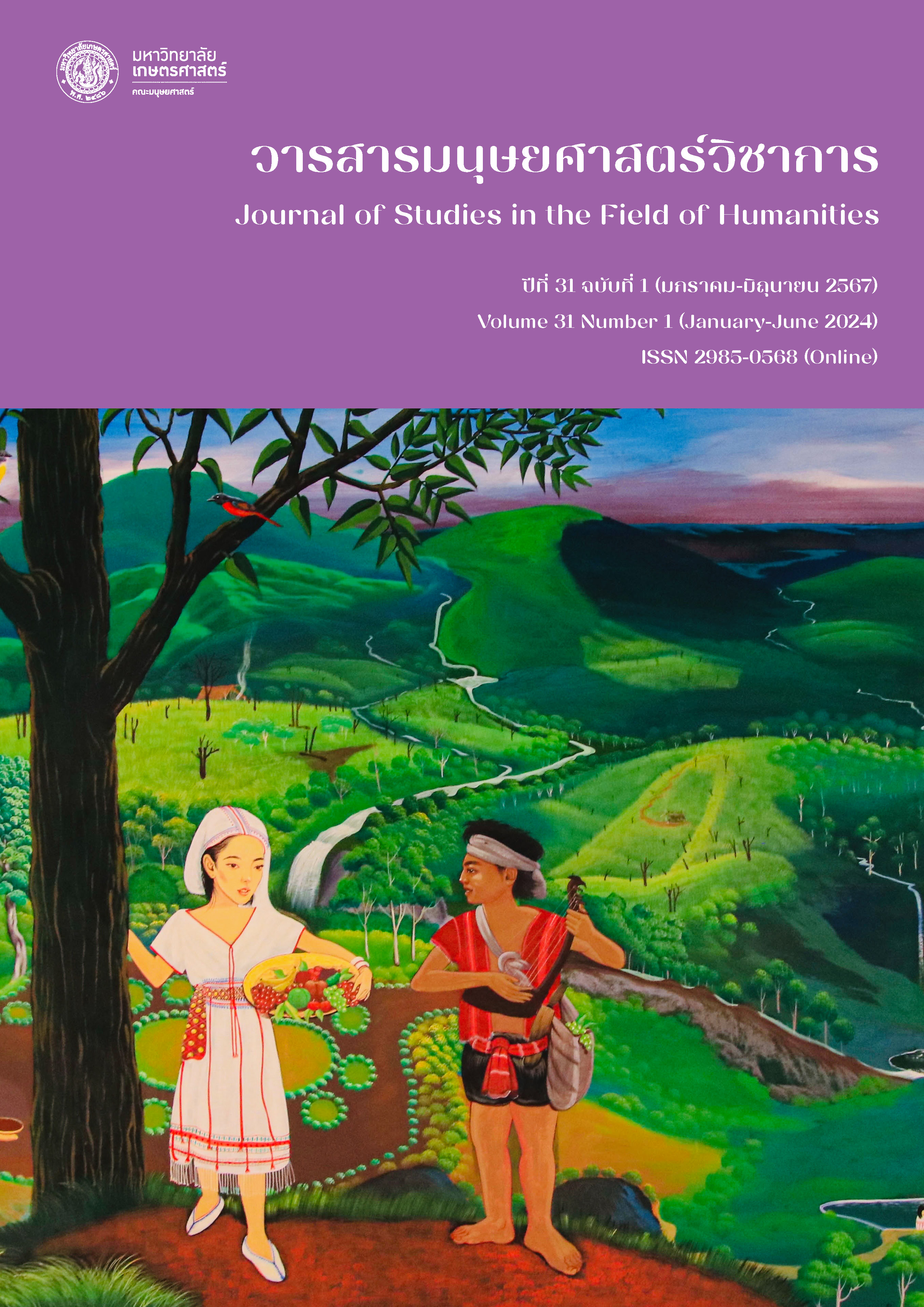The Error Analysis of Chinese Translation of Airport Public Signs in Thailand
Main Article Content
Abstract
The purpose of this research was to analyze the translation errors of Chinese public signs appearing in 16 airports in Thailand from 2019 to 2022 by random sampling. The research instrument was an error analysis table using percentages and frequency distribution. The translation theory of Yanfu's “faithfulness-expressiveness-elegance” (2009) and Kanokporn Noomthong's 10 principles for translating Thai into Chinese (2011) were used as the conceptual frameworks for the study, and the results of the descriptive analysis were presented. The 159 Chinese public signs with translation errors were analyzed and a total of 257 errors were found, with lexical errors being the most common, 62% in total, including: 1) inconsistent translation; 2) mistranslation; 3) confusion of word meanings; 4) confusion of Hong Kong and Taiwanese terms with Chinese terms; 5) use coinages; 6) direct phonetic translation. The next most common errors were grammatical errors, with the total percentage of 23%: 1) grammatical confusion and sentence ambiguity; 2) wrong use of the word “被”; 3) wrong use of numerals and measure words; 4) wrong use of verbs; 5) grammatical errors caused by missing translations. Chinese character errors, 9% in total, included: 1) misuse of Chinese characters; 2) mixing of traditional and simplified characters; 3) use of variant characters. Punctuation errors were: 1) wrong use of punctuation marks; 2) lack of punctuation marks; 3) mixed use of Chinese and English punctuation marks; 4) wrong punctuation positions; 5) other punctuation errors. These punctuation errors accounted for 4%, with the remaining 2% being errors caused by ignoring cultural factors.
Article Details

This work is licensed under a Creative Commons Attribution-NonCommercial-NoDerivatives 4.0 International License.
References
กนกพร นุ่มทอง. (2554). ตำราการแปลภาษาไทยเป็นภาษาจีน. กรุงเทพฯ: สถาบันขงจื๊อ มหาวิทยาลัยเกษตรศาสตร์.
กนกพร นุ่มทอง, และศิริวรรณ ลิขิตเจริญธรรม. (2562). หลักและข้อควรระวังในการแปลจีน-ไทย ไทย-จีน. วารสารจีนศึกษา มหาวิทยาลัยเกษตรศาสตร์, 12(2), 105-151.
กัญญา ภูริพัฒน์. (2560). การเพิ่มการบริการด้านภาษาจีนเพื่อผลักดันชาวจีนมาเที่ยวไทย: กรณีศึกษาการท่องเที่ยวแห่งประเทศไทย (วิทยานิพนธ์มหาบัณฑิต). มหาวิทยาลัยหัวเฉียวเฉลิมพระเกียรติ, สมุทรปราการ.
จิราพร เนตรสมบัติผล, และเดชา ชาติวรรณ. (2562). ทัศนะของนักท่องเที่ยวชาวจีนที่มีต่อป้ายภาษาจีนในแหล่งท่องเที่ยวสำคัญของกรุงเทพมหานคร. วารสารราชภัฏเพชรบูรณ์สาร, 21(2), 99-107.
เซินเย่, และกนกพร นุ่มทอง. (2565). การวิเคราะห์ข้อผิดพลาดในการแปลป้ายสาธารณะภาษาจีนและการกำหนดมาตรฐานป้ายสาธารณะในประเทศไทย. วารสารจีนศึกษา มหาวิทยาลัยเกษตรศาสตร์, 15(1), 240-285.
นูรีซัน อาลี. (2557). มุสลิมพลัส: แอพพลิเคชัน เพื่ออำนวยความสะดวกในการละหมาด (สารนิพนธ์มหาบัณฑิต). มหาวิทยาลัยธุรกิจบัณฑิตย์, กรุงเทพฯ.
บุรินทร์ ศรีสมถวิล. (2562). การก้าว “ไม่” ข้ามความเป็นอื่นด้านภาษาในพระราชนิพนธ์เรื่อง “แก้วจอมซน” ฉบับพากย์จีน. วารสารจีนศึกษา มหาวิทยาลัยเกษตรศาสตร์, 12(2), 259-315.
สหัทยา สิทธิวิเศษ. (2564). การวิเคราะห์ข้อผิดพลาดและสาเหตุข้อผิดพลาดในการแปลภาษาจีน บนป้ายสาธารณะในจังหวัดเชียงราย. วารสารมนุษยศาสตร์และสังคมศาสตร์ปริทัศน์ มหาวิทยาลัยราชภัฏลำปาง, 9(1), 88-98.
Landry, R., & Bourhis, R. Y. (1997). Linguistic landscape and ethnolinguistic vitality: An empirical study. Journal of Language and Social Psychology, 16(1), 23-49.
Vinay, J. P., & Darbelnet, J. (1995). Comparative stylistics of French and English: A methodology for translation. England: John Benjamins Publishing.
段连城. (1990). 呼吁: 请译界同仁都来关心对外宣传.中国翻译, 5, 2-10.
戴宗显,吕和发. (2005). 公示语汉英翻译研究——以 2012 年奥运会主办城市伦敦为例.中国翻译, 26(6), 38-42.
赫胥黎, 严复. (2009). 天演论(严复,译者). 北京: 中国青年出版社.
黄伯荣, 廖旭东. (2002). 现代汉语. 北京: 高等教育出版社.
李琰. (2018).中国翻译协会年会:做好公示语翻译提升城市国际形象. Retrieved from http://world. people.com.cn/n1/2018/1121/c1002-30414311.html.
吕和发, 蒋璐. (2013). 公示语翻译教程. 北京: 清华大学出版社.
苏培成. (2013). 近百年来汉字的简化与规. Retrieved from http://www.moe.gov.cn/jyb_xwfb/xw_fbh/moe_2069/s7135/s7562/s7569/201308/t20130827_156355.html.


